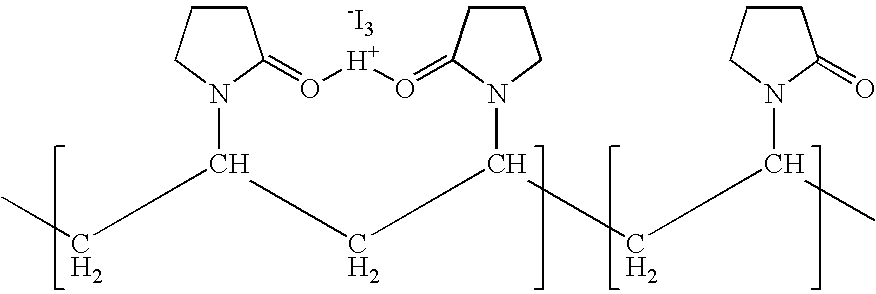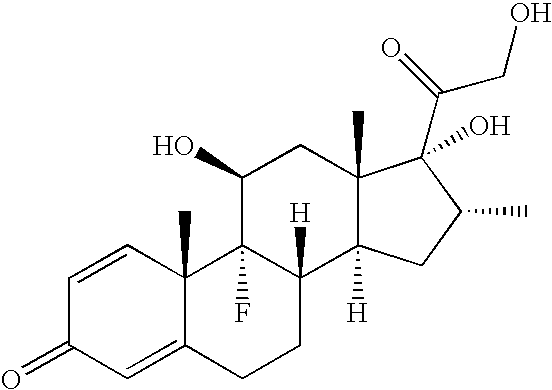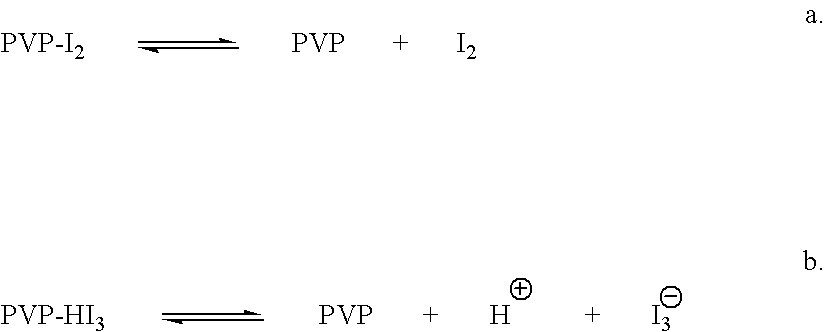Ophthalmic compositions comprising povidone-iodine
a technology of ophthalmic compositions and povidones, which is applied in the field of ophthalmic disorders, can solve the problems of accidental contact with contaminating materials, no currently available antimicrobial/anti-inflammatory or antimicrobial/steroid combinations are useful, etc., and achieve the effect of eliminating the undesired irritating effect of pvp-i and increasing the amount of ligh
- Summary
- Abstract
- Description
- Claims
- Application Information
AI Technical Summary
Benefits of technology
Problems solved by technology
Method used
Image
Examples
example 1
Production of Povidone-Iodine / Dexamethasone Suspensions
[0052]
Amount (wt. %)Povidone-Iodine (PVP-I)0.0 to 4.0Dexamethasone, Micronized, USP0.1EDTA, USP0.01Sodium Chloride, USP0.3Sodium Sulfate, USP1.2Tyloxapol, USP0.05Hydroxyethylcellulose0.25Sulfuric Acid and / orq.s. for pH adjustment to 5.7-6.0Sodium hydroxideSterile water, USPq.s. to 100
[0053]Experimental Procedures:
[0054]In a 1000 mL beaker was added 400 g sterile water, hydroxyethylcellulose (2.25 g, 0.25% w / w) was added under vigorous stirring with an overhead stirrer. Sodium chloride (2.70 g, 0.3% w / w) was slowly added while dissolving, followed by addition of EDTA (0.09 g, 0.01% w / w) and sodium sulfate (10.8 g, 1.2% w / w). After stirring for 10 minutes, tyloxapol (0.45 g, 0.05% w / w) dissolved in water was transferred into the above solution. The reaction mixture was stirred for 1 hour and q.s. to 540 g with sterile water and was stirred for another 10 minutes to give “bulk solution 1.”
[0055]60 g each of the bulk solution 1 was ...
example 2
Production of Solutions of Povidone-Iodine / Dexamethasone Sodium Phosphate; Povidone-Iodine / Prednisolone Sodium Phosphate; and Povidone-Iodine / Ketorolac
[0058]In a similar manner, solutions of A00C01, A03C01, A05C01, A10C01, A15C01, A00D01, A03D01, A05D01, A10D01, A15D01, A00K01, A05K01, A10K01, and A15K01 were produced.
[0059]The LC-MS spectra of A05C01, A10C01, and A15C01 confirmed the dexamethasone phosphoric acid (MH+=472.9) peak. The LC-MS spectra of A05D01, A10D01, and A15D01 confirmed the prednisolone phosphoric acid (MH+=440.9) peak.
[0060]However, the LC-MS experiments of A05K01 and A10K01 confirmed the finding of reaction between PVP-I and ketorolac tromethamine, For A05K01, there was a small amount of ketorolac left in the sample (MH+=256.1), the major peak is: MH+=381.9. For A10K01 and A15K01, there was no ketorolac left and has converted to a new compound (MH+=381.9) completely.
[0061]LC-MS experiments of A00B01P008 (control), A05B01P008 and A10B01P008 confirmed the finding ...
example 3
Production of Povidone-Iodine / Dexamethasone / Proparacaine Suspensions
[0062]
Amount (wt. %)PVP-I0.0 to 1.5Dexamethasone, Micronized, USP0.1Proparacaine hydrochloride, USP0.08%EDTA, USP0.01Sodium Chloride, USP0.3Sodium Sulfate, USP1.2Tyloxapol, USP0.05Hydroxyethylcellulose0.25Sulfuric Acid and / orq.s. for pH adjustment to 5.7-5.9Sodium hydroxideSterile water, USPq.s. to 100
[0063]In a 400 mL beaker was added 100 g sterile water, hydroxyethylcellulose (0.75 g, 0.25% w / w) was added under vigorous stirring with an ARROW overhead stirrer. Sodium chloride (0.9 g, 0.3% w / w) was slowly added while dissolving, followed by addition of EDTA (0.03 g, 0.01% w / w), sodium sulfate (3.6 g, 1.2% w / w) and proparacaine hydrochloride salt (0.24 g, 0.08% w / w) sequentially. After stirring for 10 minutes, tyloxapol (0.15 g, 0.05% w / w) dissolved in water was transferred into the above solution. The reaction mixture was stirred for 1 hour and dexamethasone (0.3 g, 0.1% w / w) was added and homogenized for 10 minute...
PUM
| Property | Measurement | Unit |
|---|---|---|
| volume | aaaaa | aaaaa |
| volume | aaaaa | aaaaa |
| pH | aaaaa | aaaaa |
Abstract
Description
Claims
Application Information
 Login to View More
Login to View More - R&D
- Intellectual Property
- Life Sciences
- Materials
- Tech Scout
- Unparalleled Data Quality
- Higher Quality Content
- 60% Fewer Hallucinations
Browse by: Latest US Patents, China's latest patents, Technical Efficacy Thesaurus, Application Domain, Technology Topic, Popular Technical Reports.
© 2025 PatSnap. All rights reserved.Legal|Privacy policy|Modern Slavery Act Transparency Statement|Sitemap|About US| Contact US: help@patsnap.com



